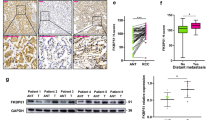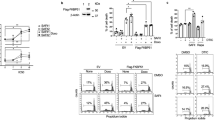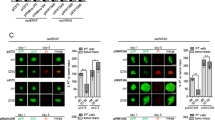Abstract
FK506-binding protein 51 (FKBP51) is an immunophilin with isomerase activity, which performs important biological functions in the cell. It has recently been involved in the apoptosis resistance of malignant melanoma. The aim of this study was to investigate the possible role of FKBP51 in the control of response to ionizing radiation (Rx) in malignant melanoma. FKBP51-silenced cells showed reduced clonogenic potential after irradiation compared with non-silenced cells. After Rx, we observed apoptosis in FKBP51-silenced cells and autophagy in non-silenced cells. The FKBP51-controlled radioresistance mechanism involves NF-κB. FKBP51 was required for the activation of Rx-induced NF-κB, which in turn inhibited apoptosis by stimulating X-linked inhibitor of apoptosis protein and promoting authophagy-mediated Bax degradation. Using a tumor–xenograft mouse model, the in vivo pretreatment of tumors with FKBP51-siRNA provoked massive apoptosis after irradiation. Immunohistochemical analysis of 10 normal skin samples and 80 malignant cutaneous melanomas showed that FKBP51 is a marker of melanocyte malignancy, correlating with vertical growth phase and lesion thickness. Finally, we provide evidence that FKBP51 targeting radiosensitizes cancer stem/initiating cells. In conclusion, our study identifies a possible molecular target for radiosensitizing therapeutic strategies against malignant melanoma.
Similar content being viewed by others
Log in or create a free account to read this content
Gain free access to this article, as well as selected content from this journal and more on nature.com
or
Abbreviations
- ABCG2:
-
ATP-binding cassette subfamily G member 2
- Becn-1:
-
Beclin-1
- CMM:
-
cutaneous malignant melanoma
- FKBP51:
-
FK506 binding protein 51
- IκB:
-
inhibitor of κ-light-chain-enhancer of activated B cells
- IKK:
-
IκB kinase complex
- LC3:
-
light chain 3
- MFI:
-
mean fluorescence intensity
- NF-κB:
-
nuclear factor of κ-light-chain-enhancer of activated B cells
- NS:
-
non-silencing
- Rx:
-
ionizing radiation
- siRNA:
-
short interfering RNA
- xIAP:
-
X-linked inhibitor of apoptosis protein
- zVAD:
-
z-Valine–Alanine–Aspartic acid
References
Norris LB, Beam S . Multidisciplinary perspectives on melanoma treatment. Updates from the 44th Annual Meeting of the American Society of Clinical Oncology, The Oncology Nurse 2008; 1: 1–7.
Dewey WC, Ling CC, Meyn RE . Radiation-induced apoptosis: relevance to radiotherapy. Int J Radiat Oncol Biol Phys 1995; 33: 781–796.
Wallace SS . DNA damages processed by base excision repair: biological consequences. Int J Radiat Biol 1994; 66: 579–589.
Hengartner MO . The biochemistry of apoptosis. Nature 2000; 407: 770–776.
Elliott A, Reiners Jr JJ . Suppression of autophagy enhances the cytotoxicity of the DNA-damaging aromatic amine p-anilinoaniline. Toxicol Appl Pharmacol 2008; 232: 169–179.
Ogata M, Hino S, Saito A, Morikawa K, Kondo S, Kanemoto S et al. Autophagy is activated for cell survival after endoplasmic reticulum stress. Mol Cell Biol 2006; 26: 9220–9231.
Eskelinen EL . New insights into the mechanisms of macroautophagy in mammalian cells. Int Rev Cell Mol Biol 2008; 266: 207–247. Review.
Baehrecke EH . Autophagy: dual roles in life and death? Nat Rev Mol Cell Biol 2005; 6: 505–510. Review.
Mathew R, Karantza-Wadsworth V, White E . Role of autophagy in cancer. Nat Rev Cancer 2007; 7: 961–967.
Romano MF, Avellino R, Petrella A, Bisogni R, Romano S, Venuta S . Rapamycin inhibits doxorubicin-induced NF-kappaB/Rel nuclear activity and enhances the apoptosis of melanoma cells. Eur J Cancer 2004; 40: 2829–2836.
Johnson GE, Ivanov VN, Hei TK . Radiosensitization of melanoma cells through combined inhibition of protein regulators of cell survival. Apoptosis 2008; 13: 790–802.
Munshi A, Kurland JF, Nishikaw T, Chiao PJ, Andreeff M et al. Inhibition of constitutively activated nuclear factor-kappaB radiosensitizes human melanoma cells. Mol Cancer Ther 2004; 3: 985–992.
Ghosh S, May MJ, Kopp EB . NF-κB and Rel proteins: evolutionarily conserved mediators of immune response. Annu Rev Immunol 1998; 16: 225–260.
Baldwin Jr AS . The NF-κB and IκB proteins: new discoveries and insights. Annu Rev Immunol 1996; 14: 649–681.
Karin M, Cao X, Greten FR, Li Z-W . NF-kappaB in cancer: from innocent bystander to major culprit. Nat Rev Cancer 2002; 2: 301–310.
Baumann M, Krause M, Hill R . Exploring the role of cancer stem cells in radioresistance. Nat Rev Cancer 2008; 8: 545–554. Review.
Romano S, Mallardo M, Chiurazzi F, Bisogni R, D'Angelillo A, Liuzzi R et al. The effect of FK506 on transforming growth factor beta signaling and apoptosis in chronic lymphocytic leukemia B cells. Haematologica 2008; 93: 75–84.
Chen AY, Okunieff P, Pommier Y, Mitchell JB . Mammalian DNA topoisomerase I mediates the enhancement of radiation cytotoxicity by camptothecin derivatives. Cancer Res 1997; 57: 1529–1536.
Kabeya Y, Mizushima N, Ueno T, Yamamoto A, Kirisako T, Noda T et al. LC3, a mammalian homologue of yeast Apg8p, is localized in autophagosome membranes after processing. EMBO J 2000; 19: 5720–5728.
Chandler JM, Cohen GM, MacFarlane M . Different subcellular distribution of caspase-3 and caspase-7 following Fas-induced apoptosis in mouse liver. J Biol Chem 1998; 273: 10815–10818.
Habraken Y, Piette J . NF-kappaB activation by double-strand breaks. Biochem Pharmacol 2006; 72: 1132–1141. Review.
Copetti T, Bertoli C, Dalla E, Demarchi F, Schneider C . p65/RelA modulates BECN1 transcription and autophagy. Mol Cell Biol 2009; 29: 2594–2608.
Kim H, Rafiuddin-Shah M, Tu HC, Jeffers JR, Zambetti GP, Hsieh JJ et al. Hierarchical regulation of mitochondrion-dependent apoptosis by BCL-2 subfamilies. Nat Cell Biol 2006; 8: 1348–1358.
Zhou S, Schuetz JD, Bunting KD, Colapietro AM, Sampath J, Morris JJ et al. The ABC transporter Bcrp1/ABCG2 is expressed in a wide variety of stem cells and is a molecular determinant of the side-population phenotype. Nat Med 2001; 7: 1028–1034.
Monzani E, Facchetti F, Galmozzi E, Corsini E, Benetti A, Cavazzin C et al. Melanoma contains CD133 and ABCG2 positive cells with enhanced tumourigenic potential. Eur J Cancer 2007; 43: 935–946.
Hocker TL, Singh MK, Tsao H . Melanoma genetics and therapeutic approaches in the 21st century: moving from the benchside to the bedside. J Invest Dermatol 2008; 128: 2575–2595.
Poeck H, Besch R, Maihoefer C, Renn M, Tormo D, Morskaya SS . 5′-Triphosphate-siRNA: turning gene silencing and Rig-I activation against melanoma. Nat Med 2008; 14: 1256–1263.
Sinars CR, Cheung-Flynn J, Rimerman RA, Scammell JG, Smith DF, Clardy J . Structure of the large FK506-binding protein FKBP51, an Hsp90-binding protein and a component of steroid receptor complexes. Proc Natl Acad Sci USA 2003; 100: 868–873.
Bouwmeester T, Bauch A, Ruffner H, Angrand PO, Bergamini G, Croughton K et al. A physical and functional map of the human TNF-alpha/NF-kappaB signal transduction pathway. Nat Cell Biol 2004; 6: 97–105.
Naumann U, Bähr O, Wolburg H, Altenberend S, Wick W, Liston P et al. Adenoviral expression of XIAP antisense RNA induces apoptosis in glioma cells and suppresses the growth of xenografts in nude mice. Gene Ther 2007; 14: 147–161.
Zabierowski SE, Herlyn M . Learning the ABCs of melanoma-initiating cells. Cancer Cell 2008; 13: 185–187.
Schatton T, Murphy GF, Frank NY, Yamaura K, Waaga-Gasser AM, Gasser M et al. Identification of cells initiating human melanomas. Nature 2008; 451: 345–349.
Baughman G, Wiederrecht GJ, Faith Campbell N, Martin MM, Bourgeois S . FKBP51, a novel T-cell specific immunophilin capable of calcineurin inhibition. Mol Cell Biol 1995; 15: 4395–4402.
Benassi B, Zupi G, Biroccio A . Gamma-glutamylcysteine synthetase mediates the c-Myc-dependent response to antineoplastic agents in melanoma cells. Mol Pharmacol 2007; 72: 1015–1023.
Trotta PP, Harrison Jr SD . Evaluation of the antitumor activity of recombinant human gamma-interferon employing human melanoma xenografts in athymic nude mice. Cancer Res 1987; 47: 5347–5353.
Giard DJ, Aaronson SA, Todaro GJ, Arnstein P, Kersey JH, Dosik H et al. In vitro cultivation of human tumors: establishment of cell lines derived from a series of solid tumors. J Natl Cancer Inst 1973; 51: 1417–1423.
Franken NAP, Rodermond HM, Stap J, Haveman J, van Bree C . Clonogenic assay of cells in vitro. Nat Protoc 2006; 1: 2315–2319.
Staibano S, Pepe S, Lo Muzio L, Somma P, Mascolo M, Argenziano G . Poly(adenosine diphosphate-ribose) polymerase 1 expression in malignant melanomas from photoexposed areas of the head and neck region. Hum Pathol 2005; 36: 724–731.
Acknowledgements
The authors are grateful to Professor Eric Baehrecke (University of Massachusetts Medical School, Worcester, MA, USA) for advice and helpful discussion, Dr. Raffaele Liuzzi (Institute of Biostructure and Bio-Imaging National Research Council, Naples, Italy) for contribution to statistical analysis, Professor Luigi Del Vecchio (CEINGE, Naples, Italy) for cell sorting, the Electron Microscopy Unit at the Institute of Biotechnology, University of Helsinki for access to equipment and technical help. It is stated that no conflict of interest exists. The work is supported by funds from the Italian Association for Cancer Research (AIRC) and MIUR (Ministero Istruzione, Università e Ricerca).
Author information
Authors and Affiliations
Corresponding author
Additional information
Edited by H Ichijo
Rights and permissions
About this article
Cite this article
Romano, S., D'Angelillo, A., Pacelli, R. et al. Role of FK506-binding protein 51 in the control of apoptosis of irradiated melanoma cells. Cell Death Differ 17, 145–157 (2010). https://doi.org/10.1038/cdd.2009.115
Received:
Revised:
Accepted:
Published:
Issue date:
DOI: https://doi.org/10.1038/cdd.2009.115
Keywords
This article is cited by
-
Identification and verification of a prognostic autophagy-related gene signature in hepatocellular carcinoma
Scientific Reports (2024)
-
The inhibition of FKBP5 protects β-cell survival under inflammation stress via AKT/FOXO1 signaling
Cell Death Discovery (2023)
-
Continuous ZnO nanoparticle exposure induces melanoma-like skin lesions in epidermal barrier dysfunction model mice through anti-apoptotic effects mediated by the oxidative stress–activated NF-κB pathway
Journal of Nanobiotechnology (2022)
-
Transcriptome sequencing reveals a lncRNA–mRNA interaction network in extramammary Paget’s disease
BMC Medical Genomics (2021)
-
Alternative macrophage polarisation associated with resistance to anti-PD1 blockade is possibly supported by the splicing of FKBP51 immunophilin in melanoma patients
British Journal of Cancer (2020)



